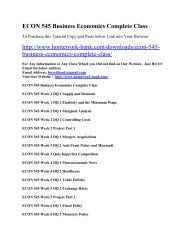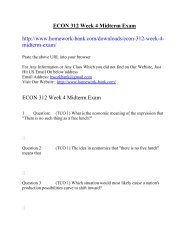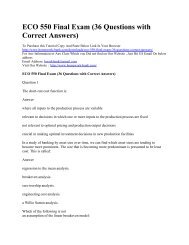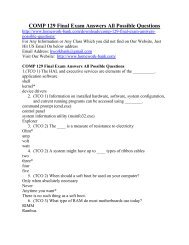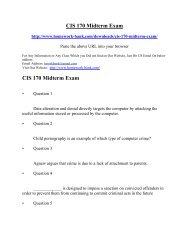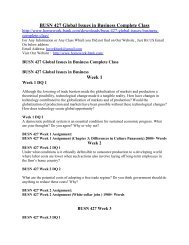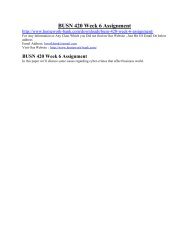o_19i2p1hv3jeu10hr1n4f130kp3d34.pdf
For Any Information or Any Class Which you Did not find on Our Website , Just Hit US Email On below address Email Address: hworkbank@gmail.com Visit Our Website : http://www.homework-bank.com/
For Any Information or Any Class Which you Did not find on Our Website , Just Hit US Email On below address
Email Address: hworkbank@gmail.com
Visit Our Website : http://www.homework-bank.com/
Create successful ePaper yourself
Turn your PDF publications into a flip-book with our unique Google optimized e-Paper software.
ECON 312 Midterm Solutions VERSION 1-2<br />
http://www.homework-bank.com/downloads/econ-312-midtermsolutions-version-1-2-urban-land-economics/<br />
Economics 312 Midterm Solutions VERSION 1-2 Urban Land Economics<br />
Midterm Exam #1<br />
1) The effect of a (ceteris paribus) decrease in the cost of home production will be to<br />
2) An increase in transport costs that has no effect on production costs (home or factory) will<br />
3) A decrease in factory production costs (ceteris paribus) will<br />
4) The building of the Canadian Pacific Railroad (which connected Toronto to the West) would<br />
have<br />
5) According to Jared Diamond’s “Guns, Germs, and Steel” hypothesis, which of the following<br />
contributed to the dominant world position of European civilization by the mid-1800s?<br />
6) Agglomeration externalities can arise due to<br />
7) A piece of land that rents for $10,000 a year should sell for ________ if the interest rate is 5%<br />
and people expect the interest rate and rent to stay constant forever.<br />
8) Assume that potential land users are equally capable (profitable) in their line of business, and<br />
that rental contracts are continuously renegotiated (i.e., there are no long-term contracts). The<br />
Leftover Principle says that<br />
9) According to Ed Glaeser in Triumph of the City, cities can attract talent by<br />
10) According to Ed Glaeser in Triumph of the City cities in decline (like Detroit) can benefit<br />
from<br />
End Section 1.<br />
Section 2: Short Answers<br />
1) 15 points<br />
Consider a region with a population that is divided across two cities. The questions below ask<br />
you about different possible configurations of this region. Utility per worker curves are given for<br />
each city in the diagrams below. Recall that utility per worker is increasing in income and<br />
decreasing in congestion and rental costs. Consider the following three cases:
Is this an equilibrium? If so, is it stable? Are the cities at their socially optimal size?<br />
It is an equilibrium but is not stable. The cities are not at their optimal size.<br />
Is this an equilibrium? If so, is it stable? Are the cities at their socially optimal size?<br />
Economics 312 Urban Land Economics<br />
VERSION 2<br />
SOLUTIONS<br />
Midterm Exam #2<br />
Section 1: Multiple Choice (3 points each)<br />
Select the most appropriate answer, and carefully bubble in the letter of the answer on your NCS<br />
marking card.<br />
Questions 1-4 refer to the following setup and diagram.<br />
Consider a farmer choosing between three pieces of land, each of different fertility. The world<br />
price of grain is $10 a bushel and is expected to remain fixed. Each diagram shows the cost<br />
curves associated with annual production on the land. Average production cost (non-rent costs<br />
per unit) at the profit maximizing quantity is denoted in each diagram. Assume all farmers have<br />
the same productivity on a given piece of land and assume free entry and a competitive market<br />
for land.<br />
1) Which parcel—after rent is paid—will yield the highest profits for the farmer?<br />
A) All will yield the same profits.<br />
B) All will yield negative profits and so won’t be farmed.<br />
C) Parcel I.<br />
D) Parcel II.<br />
1<br />
E) Parcel III.<br />
2) Given the annual rent earned by Parcel II in equilibrium, what would we expect Parcel II to<br />
sell for? Assume the annual interest rate is 5%<br />
A) $800,000<br />
B) $1,440,000<br />
C) $8,000<br />
D) $160,000<br />
E) None of the above.<br />
3) The pre-rent profit associated with the least fertile parcel of land is
A) $20,000<br />
B) $47,500<br />
C) $50,000<br />
D) $2,000<br />
E) $2,500<br />
4) Suppose that instead of remaining fixed, the world price of grain falls by $0.25 per bushel and<br />
that the price decrease is permanent. Which of the following statements is true?<br />
I. With continually renewed rental contracts, the farmers experience a decrease in overall profits.<br />
II. With continually renewed rental contracts, the landlords experience a decrease in rental<br />
income.<br />
III. With long-term rental contracts (assume 1 year contracts), both farmers and landlords suffer<br />
from the price decrease.<br />
A) I and III only.<br />
B) II and III only.<br />
C) I only.<br />
D) II only.<br />
E) III only.<br />
5) Holding city population constant, cities in China have greater population density than cities in<br />
Canada. Which of the following is likely to contribute to the relatively greater density of Chinese<br />
cities?<br />
I. The typical Canadian is more likely to drive a car than the typical Chinese. II. China has a<br />
more developed highway system than Canada.<br />
III. The typical Chinese person earns less income than the typical Canadian.<br />
A) I only.<br />
B) II only.<br />
C) I and III only.<br />
2<br />
D) I and II only.<br />
E) I, II and III.<br />
6) Assume all land users prefer locating as near as possible to the center of the city. Consider the<br />
bid-rent function for office firms. Assume that office firms experience technological change that<br />
increases their ability to engage in factor substitution, while the technology of residential and<br />
manufacturing land use remains unchanged. The change in technology for office firms will<br />
I. increase the convexity of manufacturing and residential bid-rent functions. II. increase the<br />
convexity of the office bid-rent function.<br />
III. allow office firms to more effectively outbid other firms for land near the city center.
A) II and III only.<br />
B) I, II, and III.<br />
C) I only.<br />
D) II only.<br />
E) III only.<br />
7) Policies that would reduce suburban sprawl include<br />
I. Higher gas taxes<br />
II. Increased development fees<br />
III. Agricultural subsidies<br />
A) I only.<br />
B) II only.<br />
C) III only.<br />
D) I and II only.<br />
E) I, II and III.<br />
8) Which of the following has NOT been a major contributor to decentralization of cities over<br />
the past 100 years.<br />
A) Advances in the technology of high-rise building construction.<br />
B) The rise of the car.<br />
C) The development of highway systems.<br />
D) The rise of truck transport for local shipping by manufacturers.<br />
E) The rise of truck transport for long-distance shipping by manufacturers.<br />
9) According to Ed Glaeser, in Triumph of the City, which of the following statements is/are<br />
true?<br />
3<br />
I. Allowing low-rise historic buildings to be replaced with high-rise apartment buildings will<br />
lower the cost of living.<br />
II. No historic buildings should ever be preserved, when it is profitable to replace them with<br />
newer buildings.<br />
III. Restrictions on development in anti-development cities will lead to sprawl in prodevelopment<br />
cities.<br />
A) I only.<br />
B) II only.<br />
C) III only.
D) I and III only.<br />
E) I, II and III.<br />
10) According to Glaeser, the key innovations that made skyscrapers feasible were:<br />
I. Steel beams.<br />
II. Elevators<br />
III. Thick lower walls.<br />
A) I only.<br />
B) II only.<br />
C) III only.<br />
D) I and II only.<br />
E) I, II and III.<br />
End Section 1.<br />
Section 2: Short Answers<br />
1) (10 points total)<br />
4<br />
a) 7 points<br />
Consider the case of two cities, Victoria and Vancouver. Utility per worker curves are given for<br />
each city in the diagram below, as are current (mythical) populations. Suppose that the city of<br />
Victoria pursues an innovative traffic management program that leads to shorter commutes<br />
which increases the quality of life for its residents. There is no policy change in Vancouver.<br />
Assume the utility per worker curve for Victoria remains below that of Vancouver after the<br />
policy change.<br />
Using the diagram below, clearly illustrate the shift in equilibrium populations in each city that<br />
results from the policy change. Clearly denote the pattern of migration that will occur between<br />
the two cities. Clearly label the new equilibrium population in each city and the new equilibrium<br />
utility per worker. Assume that there are no other places to live in the region, and that migration<br />
can only occur between the two cities (people cannot leave or join the region)<br />
Only the utility per worker curve for Victoria will shift, and it shifts up. Overnight, utility in<br />
Victoria rises from u to u’, while utility in Vancouver remains at u. This puts us out of<br />
equilibrium, so people begin migrating from Vancouver to Victoria. People<br />
5<br />
move out of Vancouver and into Victoria, driving utility up in Vancouver and down in Victoria<br />
(since each city is on the downward sloping side of its utility curve). We reach equilibrium
where utility is equalized across both cities again, at u”. Note that the out-migration from<br />
Vancouver should equal the in-migration to Victoria.<br />
b) 3 points<br />
Is Vancouver better off, worse off, or unaffected by the policy change in Victoria? Briefly<br />
explain why.<br />
Yes, Vancouver is better off. This is because people migrate out of Vancouver, easing<br />
congestion and high rents as they move to Victoria.<br />
Note that your explanation should get to the root cause for the rising utility in Vancouver. Don’t<br />
just say “because it moves up its utility per worker curve.” Why does it move up its utility per<br />
worker curve? Because given where Vancouver starts on its utility per worker curve, congestion<br />
and rents fall faster than wages fall (due to reduced agglomeration), as we reduce Vancouver’s<br />
population.<br />
2) (10 points total)<br />
Suppose that office, manufacturing, and residential users in a city prefer, ceteris paribus, to be<br />
closer to the center of the city. Agricultural users have a constant bid-rent that is the same at all<br />
distances from the center of the city.<br />
a) 5 points<br />
Using a diagram that shows just a residential bid-rent function and an agricultural bid-rent<br />
function, clearly illustrate how a federal gas tax would lead to more compact cities. Assume the<br />
gas tax is not refunded to local residents.<br />
This is a gas tax that is collected by the Federal government and not refunded lump-sum (like<br />
some examples you’ve seen). This sort of a tax just increases the cost of commuting for everyone<br />
who commutes. So at any distance (greater than zero) from the center of the city, residential and<br />
business users are willing to pay less for land. The higher commuting costs lead to a steeper bidrent<br />
function which moves the edge of the city in toward the center.<br />
Note that the city edge would, in reality, not move as quickly as it does in these diagrams. It<br />
would take time for land use to change and the edge of the city to retreat. These models are<br />
meant to capture basic land-use incentives, not all the adjustment dynamics.<br />
b) 5 points<br />
Using a diagram that shows just a residential bid-rent function and an agricultural bid rent<br />
function, clearly illustrate how agricultural subsidies lead to more compact cities.<br />
Agricultural subsidies increase pre-rent profits of farmers, which increases their willingness to<br />
pay (per acre) for farmland. This increases competition for land at the edge of the city, and leads
to farmers outbidding residential and business users at the edge. This makes the city more<br />
compact (it takes up less area).



